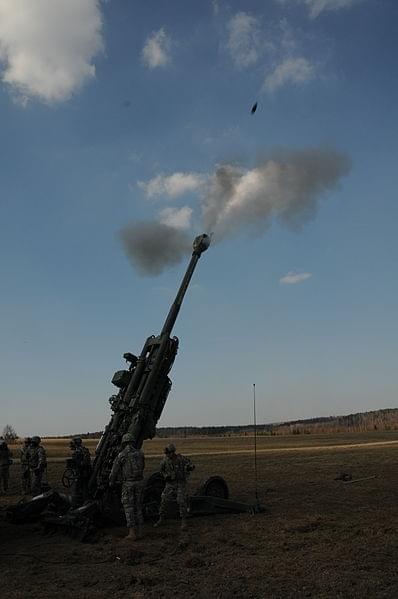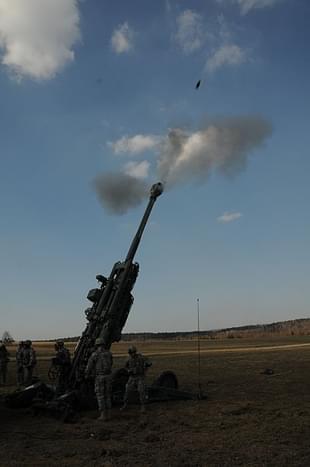Politics
Indian Army Finally Gets A Gun After 30 Years
Yusuf Unjhawala
May 19, 2015, 10:07 PM | Updated Feb 18, 2016, 12:27 PM IST
Save & read from anywhere!
Bookmark stories for easy access on any device or the Swarajya app.


The move to purchase the ultra-light M777 Howitzer is a welcome move. However, further cheering can wait till the armed forces actually acquire the weapon.
The Defence Acquisition Council on (DAC) headed by Defence Minister Manohar Parrikar on May 11th cleared the purchase of 145 BAE M777 Ultra Light Howitzer. With it it’s hoped that it finally closes the deal which was proposed back in 2008 for what is seen as a principal weapon for India’s new Mountain Strike Corps, which is being raised to deter China. It will give teeth to this strike formation and form the backbone of its firepower.
The M777 is an ultra light weight 155 mm 39 calibre towed howitzer with a range of 30 kms. At under 4000 kgs per unit, it is lighter than any other 155 mm howitzer. The Bofors guns of India weigh in at about 11,000 kgs. The light weight of the M777 is due to the use of titanium and allows the M777 to be transported by CH-47 Chinook helicopters, C-17 Globemaster & C-130 Hercules aircrafts, the V-22 Ospreys or on trucks with ease to provide increased mobility. This will allow India to deploy lethal firepower in the mountain regions on the border with China. India already has the C-17 and C130J aircrafts. The government has cleared the purchase of 15 CH47 Chinook helicopters in a meeting of the DAC under Mr Arun Jaitley in August last year.
It has been a bumpy road for the M777 acquisition by India. It was first cleared in the year 2010 by the UPA government for outright purchase in a government to government deal via Foreign Military Sale (FMS) in which the buyer gets weapons at the same price as the US armed forces. The US Defense Security Cooperation Agency (DSCA) notified the US Congress about the possible sale of 145 M777 howitzers to India for $647 million on January 22, 2010. The notification asserted that the M777 sale to India will “improve interoperability with US soldiers and marines”.
The M777 was cleared after the front runner, The Pegasus lightweight howitzer developed jointly by the Singapore Armed Forces (SAF), Defence Science and Technology Agency (DSTA) and Singapore Technology Kinetics was knocked out of the race following reports of bribery that necessitated a CBI investigation.
There was optimism that finally India will buy a howitzer after 3 decades. But the government of India under Defence Minister AK Antony didn’t move on buying the howitzer until May 2012 when under pressure from the Army under Gen V.K Singh who warned of serious gaps in the preparedness, the DAC under Mr Anthony cleared the purchase of the M777. This clearance had to be approved by the Finance Ministry and the Cabinet Committee on Security (CCS) for purchase. As with many other defence acquisition in India during the UPA rule, the process didn’t move forward.
In August 2013, The DSCA issued another note to US Congress about the possible sale of 145 M-777 howitzers to India for $885 million. This represented a hike of 37% in dollar terms but since the Rupee had depreciated since the initial announcement in 2010, what would have been a 2960 crore deal, increased to 5610 crores, an increase of 90%. The hike was due to the long delay in taking a decision to buy while the US held the price constant for 3 years and also because India asked for 30% offset in keeping with the defence procurement policy.
This put a spanner in the works. The hike and the offset proposal made the government of India to rethink on the deal. In October 2013, BAE announced that given the lack of progress from India, it will initiate the process to shut down the production line of M777. It had already spent $50 million on keeping the lines open waiting for Indian order.
https://www.youtube.com/watch?v=kb3tfk8dxvU
(An US armed forces M777 firing exercise)
In February 2014, the ministry of defence once again cleared the proposal to buy the M777 but left the final purchase to the following financial year as there was little left with the defence ministry that year. This effectively meant that the UPA II government would not go ahead with the purchase of the gun and leave it to the next government with the impending general elections.
In May 2014, the BJP led by Mr Narendra Modi came to power. In July, the then Defence Minister Mr Arun Jaitley in reply to a question from Asaduddin Owaisi, MP from the Majlis-e-Ittehadul Muslimeen said in Parliament “The case for procurement of ultra-light howitzer guns through the US government has not progressed due to cost issues and because the vendor has not been able to come up with a proposal fully compliant to the offset requirements”. It looked likely that India will scrap the plan to acquire the M777.
Just prior to US President Obama’s visit to India in January this year, the M777 deal got a new lease of life when BAE offered to shift its production line to India and make the howitzers in India under the “Make in India” mantra. BAE which is expecting orders from other governments envisioned that an Indian plant could become its single global assembly centre for the weapon. “We’ve offered to bring the gun’s assembly, integration and testing to India,” John Kelly, vice president, British Aerospace (BAE), told The Sunday Guardian. “We have identified over 40 Indian partners to substantially indigenise the components. At the heart of the proposal is to shift the assembly line (from the Hattiesburg, Mississippi facility in the US) to India, and make the gun here under transfer of technology,” said Kelly.
Under Mr Manohar Parrikar as Defence Minister, India’s artillery procurement looks to have got a boost. In his first meeting as chair in November last year, DAC sanctioned the procurement of 814 Mounted Gun System (MGS) for an estimated Rs 15,750 crore ($3 billion) under “Make in India” policy where private Indian entities will tie up with foreign gun makers. There are already many tie ups in place by leading names in the defence sector.
In June last year, Indian version of the Bofors which was upgraded to 45 Calibre from the original 39 Calibre by the Ordinance Factory Board (OFB) passed trials. Ministry of Defence ordered 114 of these guns named Dhanush to be made by OFB.
India’s Defence Research and Development Organisation (DRDO) is also developing the Advanced Towed Artillery Gun (ATAG), to build a more powerful 155 mm/52-calibre gun, with a range of 60 kilometres. This is an all-Indian project which includes private sector players.
While the latest clearance of M777 by the DAC under Mr Parrikar is a reason to cheer, given the fact that a similar clearance was granted in 2012 and nothing came of it will mean that all eyes will be on how quickly this moves to the CCS and gets clearance from the finance ministry. If all goes well, under Mr Parrikar, Indian Army will get the various types of howitzers it needs in its effort to be prepared for conflict with China and Pakistan. Artillery will play a crucial role in the shock and awe campaign that the Indian Army envisions against Pakistan in a rapid thrust across the border and in deterring China from undertaking any aggression against India.
Yusuf Unjhawala is Editor, Indian Defence Analysis, an online forum on defence and strategic affairs of India. He comments extensively on defence and geopolitics.





